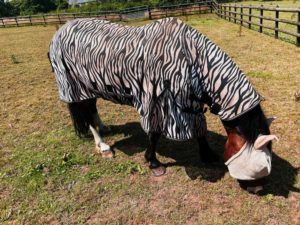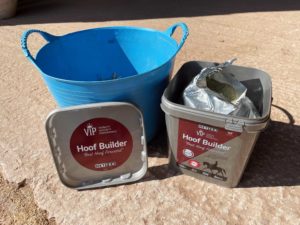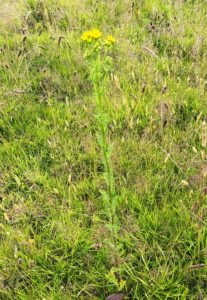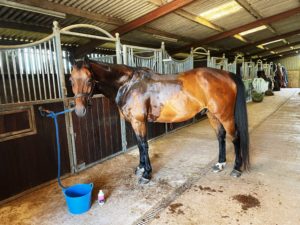Summer Blog Part 2
Summer Blog Part 2
by Dr Jim Rawlinson BVMS MBA MRCVS
The pastures might be dry and the grass not seeming to grow, but it’s hard to assess how much nutrition the horses are getting from pasture at this time of year. This is important to my horses for different reasons. Hector and Yulia are in full training so need the energy to hold condition whereas Wilfred is still growing but in light work.
Henry has a full competition schedule but is such a good doer I don’t want him to carry too much weight as we move towards September. At the start of the autumn, increased rain with warm daily temperatures can lead to a flush of grass so sudden weight gain and even laminitis is always a risk.
To keep on top of things I keep up my regular regime of weigh tape recording, noting body condition scores, and weighing hay rations. This means I have an early warning of any changes and can adjust diets accordingly.

Hector’s feet have always needed extra care. His horn grows slowly and makes shoeing a challenge, even for my very good farrier. Nutrition is central to healthy hooves so despite being on a suitable diet including a good quality balancer I decided to add in a supplement to help things. V.I.P.® Hoof Builder from Nettex contains a high level of Biotin, delivering up to 60mg per day, together with other micronutrients designed to build and maintain strong, healthy hooves, including zinc, methionine and lysine. Horn grows slowly and it might take some time for the full benefits to come through, so it’s important to keep up supplementation for the long term.

One big advantage of V.I.P.® Hoof Builder is its palatability. Hector is a fussy eater and convinced that anything new I add to his ration is an attempt to poison him. But with its pleasant apple flavour he tucked into his breakfast with no hesitation.
You can find out more on the importance of nutrition for hoof quality at https://www.nettexequine.com/expert-advice/healthy-hooves-the-foundation-of-a-sound-horse/
One of my regular tasks at this time of year is ragwort control. It’s very toxic to horses so I have a zero tolerance for it anywhere the horses can access, and especially in the fields we use for hay. Although the live green plant is considered unpalatable for horses, it’s still very toxic and they may eat it in some circumstances, especially true if the grass growth is poor and there is little other available forage. Once it dies and dries it will be readily eaten so remains a serious threat. This means effective ragwort control should be a priority wherever horses are grazed.
It will spread easily and can quickly take over a field, so keeping on top of things is essential. I don’t see this as a one-off task, rather I keep an eye out over all the summer months and remove any plants once spotted. I think this saves work in the long run and helps stop them seeding for next year. I also make a special point to walk through the hay fields before they are cut to make sure none get baled. If you buy your hay In, always buy from a reputable grower.

Hot days means hot sweaty horses. It’s important to let them cool off after exercise so I end any strenuous sessions with a stretching walk around the fields. On hot days a sponge down with cold water is a good way to bring temperatures down and wash away any sweat. If they don’t need a full hose down, then I recently started using Nettex Lavender No-Rinse Wash. This still let’s me get rid of sweat and grease without having to give them a full bath (which is much appreciated by Hector who hates bath time!)

For more information on the Nettex Equine range click here.
To find a stockist click here.
Summer Blog Part 2
by Dr Jim Rawlinson BVMS MBA MRCVS
The pastures might be dry and the grass not seeming to grow, but it’s hard to assess how much nutrition the horses are getting from pasture at this time of year. This is important to my horses for different reasons. Hector and Yulia are in full training so need the energy to hold condition whereas Wilfred is still growing but in light work.
Henry has a full competition schedule but is such a good doer I don’t want him to carry too much weight as we move towards September. At the start of the autumn, increased rain with warm daily temperatures can lead to a flush of grass so sudden weight gain and even laminitis is always a risk.
To keep on top of things I keep up my regular regime of weigh tape recording, noting body condition scores, and weighing hay rations. This means I have an early warning of any changes and can adjust diets accordingly.

Hector’s feet have always needed extra care. His horn grows slowly and makes shoeing a challenge, even for my very good farrier. Nutrition is central to healthy hooves so despite being on a suitable diet including a good quality balancer I decided to add in a supplement to help things. V.I.P.® Hoof Builder from Nettex contains a high level of Biotin, delivering up to 60mg per day, together with other micronutrients designed to build and maintain strong, healthy hooves, including zinc, methionine and lysine. Horn grows slowly and it might take some time for the full benefits to come through, so it’s important to keep up supplementation for the long term.

One big advantage of V.I.P.® Hoof Builder is its palatability. Hector is a fussy eater and convinced that anything new I add to his ration is an attempt to poison him. But with its pleasant apple flavour he tucked into his breakfast with no hesitation.
You can find out more on the importance of nutrition for hoof quality at https://www.nettexequine.com/expert-advice/healthy-hooves-the-foundation-of-a-sound-horse/
One of my regular tasks at this time of year is ragwort control. It’s very toxic to horses so I have a zero tolerance for it anywhere the horses can access, and especially in the fields we use for hay. Although the live green plant is considered unpalatable for horses, it’s still very toxic and they may eat it in some circumstances, especially true if the grass growth is poor and there is little other available forage. Once it dies and dries it will be readily eaten so remains a serious threat. This means effective ragwort control should be a priority wherever horses are grazed.
It will spread easily and can quickly take over a field, so keeping on top of things is essential. I don’t see this as a one-off task, rather I keep an eye out over all the summer months and remove any plants once spotted. I think this saves work in the long run and helps stop them seeding for next year. I also make a special point to walk through the hay fields before they are cut to make sure none get baled. If you buy your hay In, always buy from a reputable grower.

Hot days means hot sweaty horses. It’s important to let them cool off after exercise so I end any strenuous sessions with a stretching walk around the fields. On hot days a sponge down with cold water is a good way to bring temperatures down and wash away any sweat. If they don’t need a full hose down, then I recently started using Nettex Lavender No-Rinse Wash. This still let’s me get rid of sweat and grease without having to give them a full bath (which is much appreciated by Hector who hates bath time!)

For more information on the Nettex Equine range click here.
To find a stockist click here.




